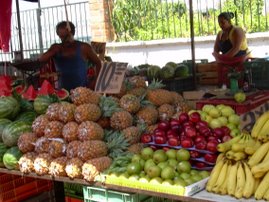


Above are three recent photos taken at the Wednesday market, or tianguis (tee-AN-gis) in Ajijic. First is a photo of some of the colorful pottery available which is made by local indigenous people. It is intended to be decorative and may contain lead which might make it unsuitable for holding hot foods. On the left, Mauricio is the man from whom we like to buy flowers each week. He is studying at the University of Guadalajara to become an English teacher. He likes to practice his English with us. Here he is posing with his daughter who likes to help him at the flower market stand. On the right is an interesting offering at the market. Soaps and cleaners are sold in bulk. You can buy laundry detergent, dish soap, fabric softener, floor cleaner, shampoo, etc. They will put it in a plastic bag for you, or you can bring your own container, 'green" and economical way to distribute these items.

A friend of ours, Rick Rhoda (in December I posted a photo of Rick in his garden when we attended a Christmas Tree Trimming party at his house) and Tony Burton have written an interesting and long overdue book covering the geography of Mexico. The 2010 book, entitled Geo-Mexico, pictured above, is an encyclopedic volume covering everything from geology, climate, water resources, economy, culture, ethnic diversity, religion, politics, and other topics which give a comprehensive picture of modern Mexico. According to Rick, who has his doctorate in geography, there is no similar book about Mexico in print. Since purchasing a copy of the book about a month ago, I have been enthralled with it, and I thought I might, over time, share some of the material on the blog. For those readers of the blog who might be interested in more information about the book, or who may want to purchase a copy, here is a link to the book's website: http://geo-mexico.com/
Did you know that Tiajuana, Mexico is closer to Juneau, Alaska than it is to Cancun, Mexico? That demonstrates vividly how large Mexico is from east to west!
Geographically, Mexico might be divided into several regions: Baja California, the norther desert area, the central highlands, and the tropical southern areas. This is an oversimplification, of course, but that's the basic scheme. The northern desert area near the US border and reaching about 600 miles south is the very arid region which most people think of when they remember Hollywood depictions of Mexico. There is little vegetation aside from cactus and other desert plants, and, as you might imagine, it is very thinly populated. Many of the rural people who do live here are desperately poor, subsisting on very little. It is also the home to major industrial cities including Monterrey, Juarez, Reynosa, and Matamoros. Many of the jobs which have been exported to Mexico are in these areas. The ethnic mix in this area is Euro-Mestizo, or lighter skinned people, and the area has a higher GDP than the south.
The Baja California area is obviously very coastal and has a hot, Mediterranean-type climate, with most of its rainfall coming in the winter, unlike the rest of Mexico. It relies heavily on tourism and caters to the may people who come there from California and other western states.
The central highlands, which includes Guadalajara east to Mexico City, is where we live. The altitude in generally above 5000 feet, so the temperature is moderate all year. 90% of the rain falls between the months of June through October, so the winters are very dry and pleasant. It is a large agricultural area with rich volcanic soil. This are is considered the cultural center of Mexico and is the home of such Mexican cultural icons as mariachi music, tequila manufacturing, charro horse shows, and much native pottery and other crafts.
The south is much poorer, has a very high indigenous population, and has the most rain in its tropical areas. The south includes the areas of Chiapas, Oaxaca, and Tabasco. It rains here all year, and flooding can be a problem. It is also an area rich in Mexican culture, but little manufacturing.
Surprisingly, the average rainfall in Mexico as a whole is about 30 inches a year, well above either the US or Canada. The problem is that the rain is unevenly distributed, with the north getting very little and the south often facing floods. The aquifers in some areas, particularly around Mexico City, are being over-used, requiring deeper drilling every year. Mexico is facing a severe water problem which is expected to get worse over time. The government is working on solutions, but they are very difficult.
I will discuss other interesting aspects covered in Geo-Mexico in future posts.
On another note, Pixie and I visited Tonala last week and picked up a couple of items for our house. As you can see below, we bought some large vases which are very popular here. People put dried flowers and other colored plant products in them. They are inexpensive and give your home a decidedly Mexican touch. We also picked up a table and chair set made of wrought aluminum. These frilly sets are also inexpensive and very popular here. Pixie, for some reason, was not happy with our white plastic set which came with the house, so we replaced it with this set.


And, of course there's Chuy. Everybody seems interested in seeing update photos of our new puppy. He is, incidentally, doing very well with learning the rules of the house, like no chewing on our fingers and doing his "business" outdoors. He always goes outside for his bathroom activities, as long as we leave the door open for him. The only thing he has not yet learned is to come to us to ask to go outside. But, at only three months, not bad, huh? Here are two photos taken today. He had his first haircut this week.


Well, on Sunday we are headed to Michoacan with our friends Paul and Jeanne to stay at a londge near a private Monarch butterfly sanctuary. On Monday we will ride up the mountain on horseback to see the thousands of Monarchs who make this area of Mexico their winter home. This time, we expect the weather to cooperate, so I should have some interesting photos to post. Our friends Doug and Kathy are coming to visit us from New Gloucester , Maine next weekend, as well. So I should have lots to report in my next posting.



































































No comments:
Post a Comment